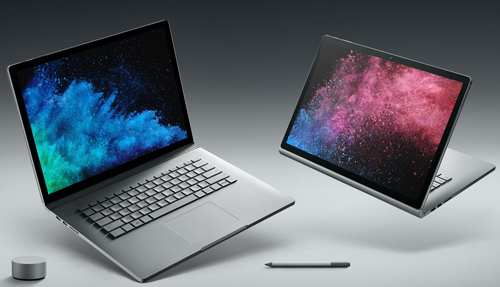News
Windows 10 Fall Creators Update Rolls Out; New Surface Book Debuts
- By Jeffrey Schwartz
- October 17, 2017
Microsoft on Tuesday took the wraps off the new Surface Book 2, in addition to announcing the general availability of the Windows 10 Fall Creators Update (previously code-named "Redstone 3").
The Windows 10 Fall Creators Update comes with a raft of new features, which Microsoft described in its announcement. Among them are support for new mixed reality devices and scenarios, security improvements, an Eye Control feature that improves the user experience for those with motor impairments, and enhancements to the Windows Console.
Unlike the Windows 10 Fall Creators Update rollout, the announcement of the new Surface Book 2 on Tuesday was an unscheduled surprise. The new device is Microsoft's most powerful Surface PC to date, and represents the next step in the company's effort to differentiate its Surface line from the highest-performing Apple MacBook Pros.
The new Surface Book 2 will be available Nov. 16, initially from the Microsoft Store, with either 13.5- or 15-inch displays. It will be up to five times more powerful than the original Surface Book, which Microsoft launched two years ago. The 13.5-inch model will start at $1,499 and the 15-inch unit at $2,499, available with either dual- or quad-core Intel 8th Generation Core processors and the current NVIDIA GeForce GTX GPUs.
 [Click on image for larger view.] The new Surface Book 2. (Source: Microsoft)
[Click on image for larger view.] The new Surface Book 2. (Source: Microsoft)
Engineered to process 4.3 trillion math operations per second, the newest Surface Books are for those who perform compute-intensive processes such as video rendering, CAD, scientific calculations and compiling code at high speeds. Also targeting gamers, the 15-inch model will include a wireless Xbox Controller. It has a 95-watt power supply and can render 1080p at 60 frames per second.
"This thing is 'Beauty and the Beast,'" said Microsoft Corporate Vice President Panos Panay, who oversees Microsoft's entire hardware lineup, during a briefing for reporters and Windows Insiders. "There's no computer, no laptop, no product, that's ever pushed this much computational power in this mobile form factor. It's quite extraordinary, the performance."
Panay emphasized that the Surface Book Pro 2, with its digital inking and mixed reality capabilities, aims to bring out the best in the new Windows 10 Fall Creators Update and Office 365. Like its predecessor, the Surface Book 2 screen detaches so it can be used as a tablet. Users can also fold it back into studio mode. It sports what Panay said is the thinnest LCD available, with a 10-point multi-touch display. It also supports a newly refined Surface Pen and the Surface Dial.
In addition to the five-fold power boost over the original Surface Book (the 13.5-inch model is four times more powerful), Panay said the Surface Book 2 is twice as powerful as the latest MacBook Pro and boasts 70 percent greater battery life in video playback mode. Microsoft is claiming a 17-hour battery life (five hours when used as a tablet), though few laptops -- from Microsoft or otherwise -- ever reach those maximums. Nevertheless, it is designed to ensure all-day use in most conditions. The 13.5-inch model weighs 3.38 pounds, with the 15-inch unit weighing 4.2 pounds with the keyboard attached.
"There has never been this much computational power in a mobile form factor this light," Panay said in a blog post announcing the Surface Book 2. "You can show off your meticulously designed PowerPoint deck or complex Pivot tables in Excel with Surface Book 2's stunningly vibrant and crisp PixelSense Display with multi-touch, Surface Pen, and Surface Dial on-screen support. You won't believe how much the colors and 3D images will pop in PowerPoint on these machines."
The 15-inch model offers just under 7 million pixels, or 260 DPI, which Microsoft claims is 45 percent more than the MacBook Pro. The 13.5-inch model produces 6 million pixels at 267 DPI (3000x2000).
Among the various configurations, the Surface Book 2s are available with a choice of Intel 7th or 8th Generation Core i5 or i7 processors and the option of dual- and quad-core processors. Depending on the model, customers can choose between 8GB or 16GB of RAM with 256GB, 512GB or 1TB of SSD storage.
About the Author
Jeffrey Schwartz is editor of Redmond magazine and also covers cloud computing for Virtualization Review's Cloud Report. In addition, he writes the Channeling the Cloud column for Redmond Channel Partner. Follow him on Twitter @JeffreySchwartz.